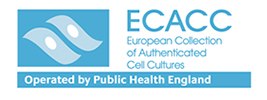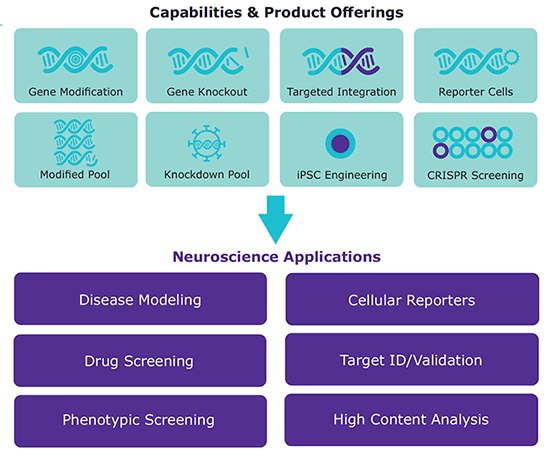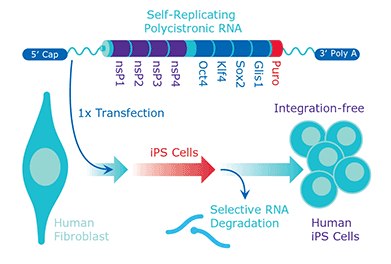Predictive Models for Neuroscience Research
Develop Predictive Neural Models
For neuroscientists, the quest for truly predictive neural models has its challenges given the brain is a very complex organ comprised of many diverse cell types, complex cell-tocell interactions and intricate signaling pathways. But new breakthroughs using molecular tools and stem cell models are now better able to mimic the physiology of the brain to help explore the origins of neurological disorders and disease. With the help of these models new treatments and even personalized therapies are being created.
Creating predictive neural models involves three processes:

Use this guide to discover each step and DEVELOP the predictive neural model you’ve been waiting for.
SELECT > Cell type
Cells that mimic the physiology of the human brain and the bloodbrain barrier (BBB) will produce more relevant and accurate results. Count on our full offering of stem cells, primary cells and other novel cell lines that are well characterized and designed specifically for neuroscience research.
CHALLENGE
Creation of more physiological in vitro culture systems that mimic in vivo environments.
SOLUTION
Neural Cell Lines
The use of immortalized cell lines has many advantages including the capability of long-term growth and ease to cultivate. Additionally, when neural stem cells (NSCs) are used they have an added benefit of selfrenewal and differentiation along specific pathways to generate physiological relevant neuronal and glial cell types of the central nervous system (CNS).
Mouse Cell Lines
Rat Cell Lines
Human Cell Lines
Product Highlight
ReNcell® VM Human Neural Stem Cell (NSC) Line
Product No. SCC008
As seen in Nature. 2015 Jul;10(7): 985–1006
Immortalized human neural progenitor cell line with the ability to readily differentiate into neurons and glial cells, making them the ideal platform for neuroscience research.
- Consistent and dependable neural stem cell culture
- Immortalized to produce a robust and consistent NSC culture
- Offers phenotype and genotype stability
- Includes multipotential neuronal and glial differentiation capacity
- Culture in optimized defined serum-free media
Ask about the NEW protocol to make a 3D cell model of Alzheimer’s Disease using ReNcell® VM cells.
SELECT > Cell type
CHALLENGE
A need for more physiological in vitro culture systems that are more comparable to in vivo environments.
SOLUTION
Primary Cells
Closely mimic in vivo conditions with primary neuronal cultures that are derived directly from tissue and maintain physiological relevance. We have partnered with Cell Applications Inc., who is a leading authority and global provider of primary human and animal cell types, to provide greater than 100 different human and animal cells, cited extensively in original, peer-reviewed research articles and patents.
RAT PRIMARY CELLS
Rat Neurons
SELECT > Cell type
CHALLENGE
Authenticated cell lines that are free of contamination (e.g. other cell lines and microbes) are of the utmost importance to safeguard reproducibility.
SOLUTION
Culture Collection Cell Lines
We have formed a working partnership with The European Collection of Authenticated Cell Cultures (ECACC), a world leader and recognized expert in the maintenance, cultivation and distribution of a unique repository of over 1,300 validated cells. Cell lines obtained from ECACC are tested for viability (plating efficiency and cell density), morphology, sterility, mycoplasma contamination and authenticity, offering the most diverse and validated selection available so you can ensure reproducible results.

ECACC Cells
CREATE > Genetic Modification
The ability to modify genes (e.g. edit or knockout genes) in cell models enables the discovery and study of novel neurological pathways. Count on our extensive portfolio of CRISPRs, ZFNs, and other technologies to engineer the predictive neural model you need.
CHALLENGE
Neural models are difficult to generate and manipulate. Novel tools and techniques are needed to overcome a variety of barriers.

SOLUTION
Genome Editing Tools
The recent advancement of functional genomic tools, like CompoZr® ZFN and CRISPR, allows researchers to knock-out, knock-in and modify genes in order to create their ideal cell model, revealing novel relationships between genes and neurological phenotypes.
CRISPR
The advent of CRISPR has been timed perfectly with a reduction in DNA sequencing costs and a recent boom in neuroscience research. Through the democratization of genome editing researchers worldwide are now able to uncover genes implicated in neural development and disease whose relationship was previously unknown. A greater depth in the understanding of the pathways involved in Alzheimer’s, schizophrenia, and a host of other neurological diseases is now a reality. In addition to using CRISPR to study cultured cells, a sizable and growing number are using this tool to generate transgenic animals enabling heretofore impossible interrogations of the brain and complex neural tissues.
Custom Research Models
Cell Design Studio
Our Cell Design Studio team is made up of experienced, dedicated scientists who work to provide solutions for your neural model needs. With in-house access to CRISPR, zinc finger nuclease, and shRNA technologies, our experts can rapidly generate knock-outs, knock-ins, and gene modifications in a variety of mammalian cell lines. Our ultimate goal is to provide you not with a cell line, but with a solution. We focus on the cell engineering details so you can focus on the science.

Technology Highlight
Cellular Reprogramming
Simplicon™ RNA Reprogramming Technology Product No. SCR550
Our reprogramming technology utilizes a selfreplicating RNA strand allowing efficient, virusfree reprogramming generating high numbers of induced pluripotent stem cells (iPSCs) with a single transfection step. Use Simplicon RNA reprogramming technology with efficient media and supporting products to provide a complete solution for modeling neurological diseases using an iPS cell model system.
See more at SigmaAldrich.com/neuro-simplicon

OPTIMIZE > Growth and Consistency
An optimized culture environment is extremely important for the reproducibility of your neural model. Depend on our well characterized specialty medias, growth factors, sterile filtration systems and 3D culture products to provide the consistency you need to advance your neuroscience research.
Technology Highlight
Neurite Outgrowth
AXIS® Axon Isolation System
Use our AXIS platform for the most advanced tool to study neurite outgrowth. This slidemounted microfluidic two-chamber system enables the deposition and culture of neural cells and the spatially controlled addition of growth factors, toxins, and other reagents. Neurite outgrowth is restricted to narrow, parallel channels, and the resultant outgrowth or collapse behavior is easily observed under a microscope. The result is a powerful platform for the study of somas, neurite outgrowth, and synapse formation.

N1E-114 cells were loaded in the lower channel and cultured for 5 days in differentiation media. The cells were then fixed and stained with DAPI (blue) and with the neuronal cell stain MAB23D0X (green).
A) Fluorescent image showing the N1E-115 cells differentiating through the microgrooves of the AXIS® device. Note that the cell bodies (somas) are entirely contained on one side of the device and only the neurites are extended through the microgrooves into the other channel. B) Higher resolution white light image of the cells and device. C) Corresponding fluorescent image. D) Overlay of images B and C to verify that the neurites extend through the microgrooves only.
OPTIMIZE > Growth and Consistency
CHALLENGE
Creating similar environmental conditions that exist in nature is essential for relevant neural models.
SOLUTION
Growth Environment
3D Cell Culture
Cells in their natural environment have constant interactions with the extracellular matrix (ECM) and other cells, regulating complex biological functions like cellular migration, apoptosis, or receptor expression. Most of these interactions are lost, or significantly reduced, in 2D cell culture. By culturing cells in the presence of ECM components, particularly ECM proteins like collagen, laminin or fibronectin, they allow you to recapitulate a 3D cell culture and produce a more predictive neural model. CHALLENGE Creating similar environmental conditions that exist in nature is essential for relevant neural models.
More at SigmaAldrich.com/neuro-3dpcell
SOLUTION
Growth Environment
Media and Growth Factors
To closely represent the in vivo environment of neural cells correct biological conditions are essential. Achieve relevant growing conditions with our well cited, sterile media options optimized for neuroscience research. And get consistent cell proliferation and differentiation with our high quality growth factors to achieve a more neurological phenotype.
Media and Growth Factors
OPTIMIZE > Growth and Consistency
CHALLENGE
A simple, reproducible method for the critical steps of accurately preparing cells and media.
SOLUTION
Sterile Filtration
Establishing a successful neural cell culture begins with optimizing cells and media with the highest standards. From challenging neuronal cell lines to minimal sample availability, count on our sterile filtration products to provide quality and reproducibility to your media and supplements.
- Stericup® and Steritop® Filter Units
Remove undesirable contaminants and sterilize your media with our high-flow rate Stericup® and Steritop® filters. This compact, stable and easy to grip system allows for very low protein binding with a wide range of membranes and volume capacities. As an added precaution it has recessed threads on the cap to safeguard against contaminants. You can also use Steritop® bottle-top devices with your own sterile capture flask or bottle. - Millex® Syringe Filters
Ensure faster flow rate for greater throughput, with maximum recovery of soluble proteins using our Millex® syringe filters. These color-coded syringe filters provide instant visual identification, reducing the risk of confusing similar-sized devices on the bench.
如要继续阅读,请登录或创建帐户。
暂无帐户?